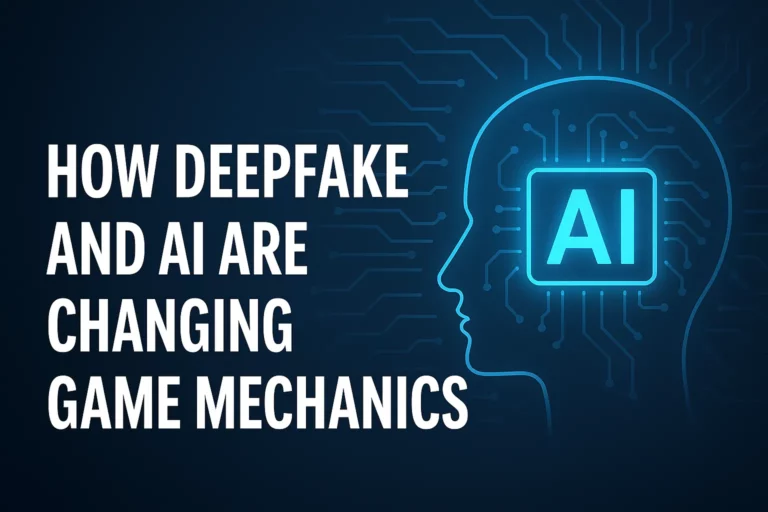The rise of synthetic actors—AI-generated characters that look, sound, and perform like humans—has opened up a fierce debate in the world of game development. Are they the next evolution in creative storytelling? Or a digital shortcut that could push human talent out of the industry?
What started as a novelty is quickly becoming a real alternative to traditional performance. With advances in AI, deepfake, and generative tools, synthetic actors are no longer just digital puppets—they can mimic emotions, voices, and facial expressions with uncanny precision. And that’s changing how games are made.
What Are Synthetic Actors?
Synthetic actors are virtual characters created or enhanced using artificial intelligence. This can mean:
- Deepfake video overlays that replicate real faces with precision
- Voice cloning that mimics the tone and cadence of human speech
- Procedural facial animation driven by neural networks
- Emotion modeling to simulate natural reactions
In game development, they are increasingly used to generate cinematic cutscenes, character animations, and even interactive dialogues without involving live actors. Unlike traditional 3D models or motion-captured performances, synthetic actors can be created entirely from data.
Why Developers Are Paying Attention
Creating realistic, expressive characters is expensive. Hiring voice actors, motion capture teams, and animators takes time and budget—especially for indie studios or experimental projects.
Synthetic actors offer several advantages:
- Cost reduction: No need for studios, shoots, or actors
- Speed: Assets can be generated in days, not weeks
- Flexibility: Revisions are easy and don’t require reshoots
- Scalability: Characters can be reused or regenerated across titles
It’s no surprise that studios—especially those working on large-scale RPGs or narrative-driven games—are exploring these tools. They’re not just using them to fill in background characters; some are experimenting with AI-led performances at the heart of their stories.
Creative Power or Ethical Dilemma?
On the surface, synthetic actors seem like a win for efficiency. But they come with a set of challenges the industry can’t ignore.
1. Job Displacement
For voice actors, motion capture performers, and character artists, the rise of synthetic replacements feels like a threat. Why pay for a full cast when you can simulate one?
Many fear a scenario where creative labor is undervalued—or worse, made obsolete. Some studios have already experimented with replacing extras and minor roles with AI-generated models.
2. Consent and Digital Likeness
Who owns a face or a voice once it’s been replicated by AI?
Deepfake tools can now recreate the likeness of real actors, sometimes even posthumously. Without clear legal boundaries, developers risk crossing ethical lines—especially when it comes to using the identities of public figures or reusing an actor’s past work.
3. Loss of Authenticity
While synthetic performances can be realistic, they often lack nuance. Human improvisation, subtle emotion, and cultural context are difficult to replicate. The danger is that storytelling becomes more mechanical—perfect on the surface, but emotionally flat.
What Games Are Already Using Synthetic Actors?
Several titles have already ventured into synthetic territory, especially in experimental or narrative-heavy formats. For example:
- Some RPGs now use AI-generated NPC dialogues that adjust in real time
- Indie devs are experimenting with voice synthesis for dynamic character narration
- Deepfake facial animation has been used in cinematic sequences to cut costs while maintaining realism
Even mainstream platforms are exploring virtual influencers and AI-powered streamers—blurring the line between fiction and performance.
Where Does This Leave Real Talent?
Despite concerns, synthetic actors aren’t necessarily replacing humans entirely—they’re becoming tools. Just like CGI didn’t eliminate practical effects, AI-generated characters can coexist with traditional acting when used wisely.
Some possibilities include:
- Hybrid performances where real actors control synthetic avatars
- Post-processing that uses AI to enhance or adjust live recordings
- AI-assisted direction where game engines use machine learning to adapt scenes dynamically
Instead of replacing performers, these tools could expand their capabilities. Actors might license their digital likenesses, work with AI as co-performers, or even direct virtual characters themselves.
What Needs to Happen Next?
To make synthetic actors a sustainable part of game development, the industry must establish:
- Ethical guidelines for consent, likeness use, and data sourcing
- Clear contracts for actors who choose to license their voice or face
- Transparency with players—letting them know when characters are synthetic
- Balance between automation and artistry, so games retain emotional depth


